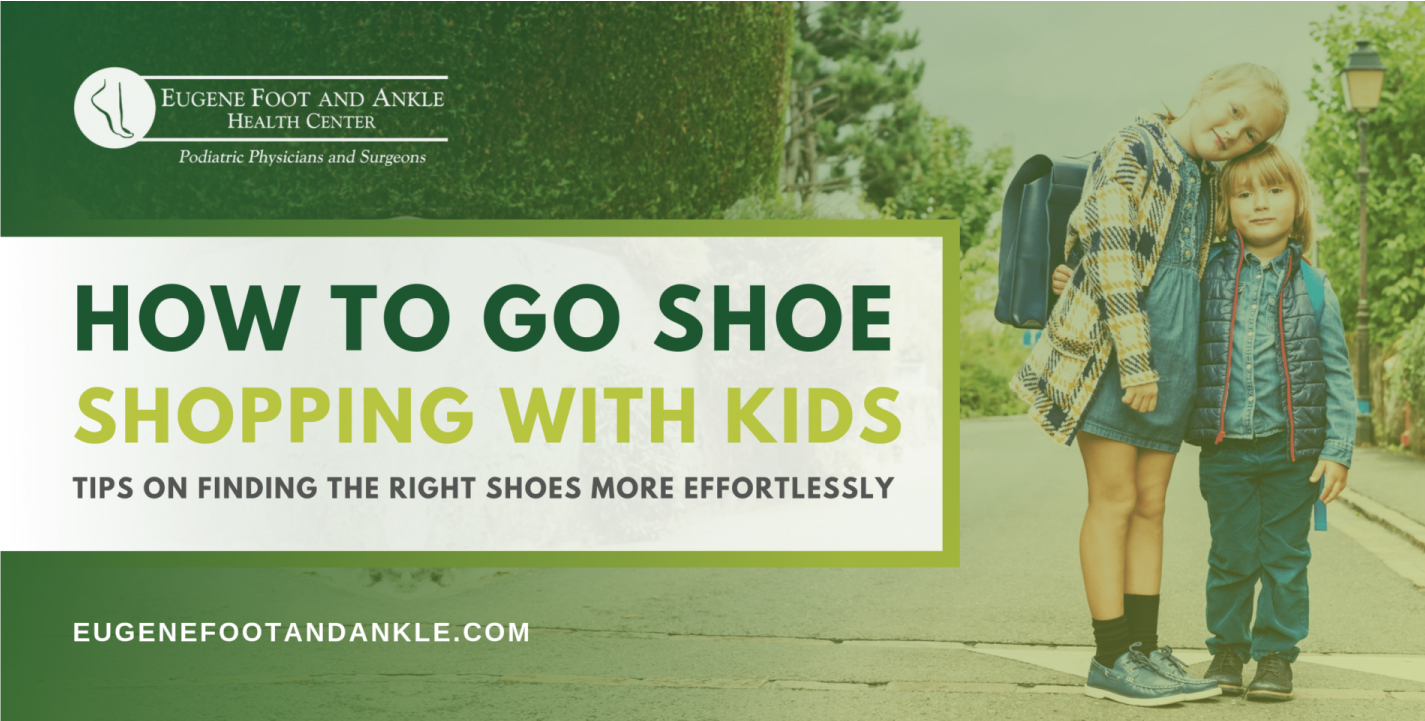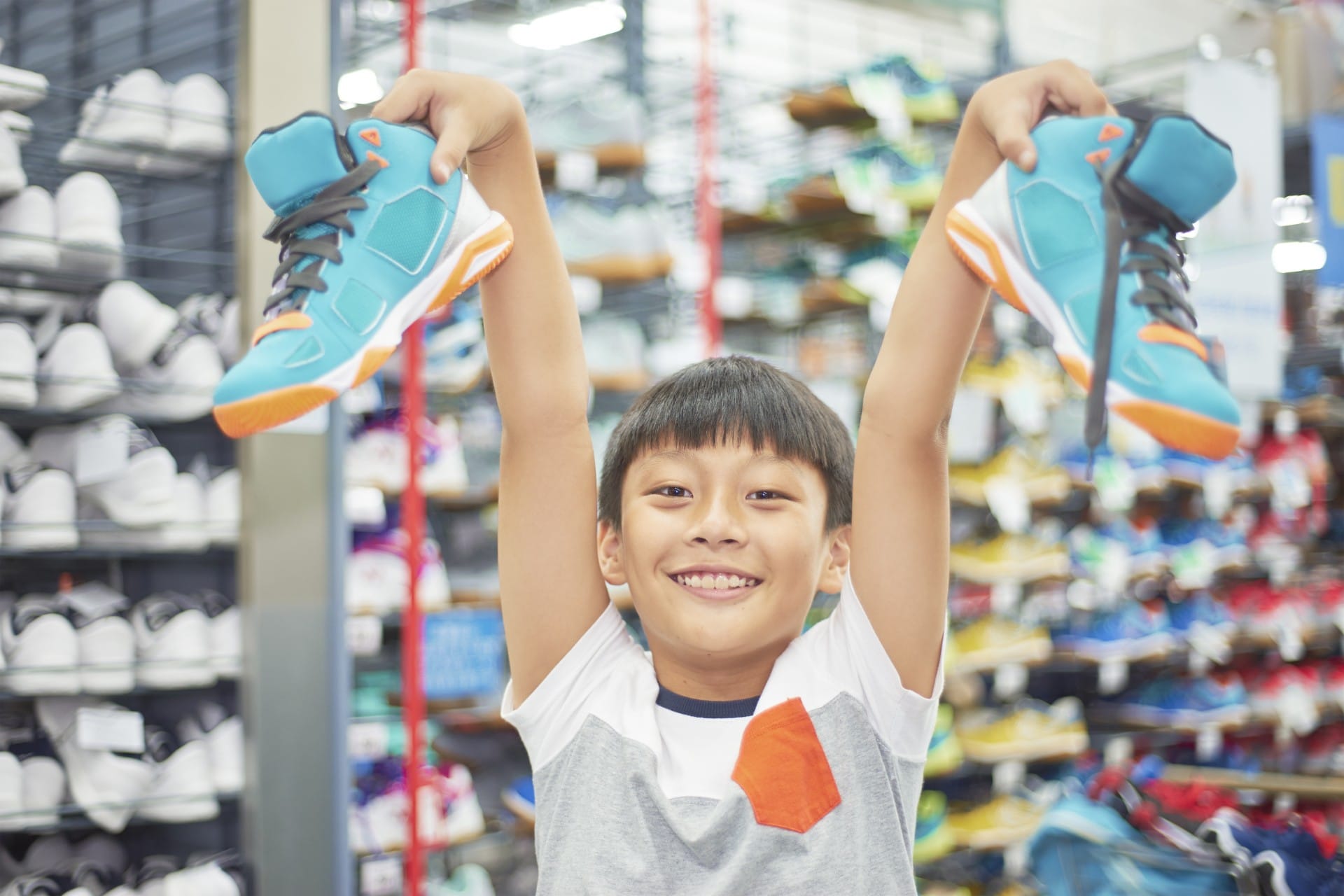Keep your Kids’ Feet Healthy with Proper Shoes
Shoe shopping for yourself? That’s frustrating enough. But finding shoes for your little one? As any parent probably knows, that can be especially fraught. Juggling their needs and desires—not to mention your budget—can be a tricky thing to do, especially if you aren’t completely sure what you’re doing or what to look for. Keeping your kids’ feet healthy starts with properly fitting shoes.
But fear not! We’re happy to share some tips to hopefully make the experience more pleasant—or at least be sure that your child goes home with a pair of shoes that will properly support their feet and allow them to run and play comfortably, at home and at school.
First, though, a quick PSA:
Keeping your Kids’ Feet Healthy is Really Important to Get Right
Sure, not exactly a shocking thing to hear from a podiatrist. But trust us: finding the right pair of shoes is important for people of all ages, but especially so for kids.
Their feet are still growing and developing, and it really is crucial that they are supported and protected properly. The wrong pair of shoes can hamper walking and impede growth, cause ingrown toenails, increase the risk of fungal and viral infections, and more.

Part I: Determining When It’s Time to Go Shopping
Kids’ feet grow fast. Really fast. In fact, if your child is very young or in the middle of a growth spurt, it’s not unusual to go through 3-4 different shoe sizes per year.
As a parent, it’s important that you’re checking the fit on your child’s shoes regularly—at least once per month. With your child standing up in his or her shoes, press down on the front of the shoe. You should be able to feel at least a quarter inch of space between the front of the shoe and the longest toe.
Other signs your child may have outgrown their shoes include:
- Shoes are bulging at the sides.
- You child appears less active or is not going out to play as much as usual.
- Your child is developing blisters or calluses on his or her feet.
- Your child tells you that their shoes are too small or their feet are hurting.
One other thing: If your child is about to start a new sports season or physical activity, go and get them a sport-specific pair of shoes. It might seem like an extravagance, but sport-specific shoes will help protect their feet from the impact forces and risks of the game they play. Regular, generic gym shoes just won’t be as effective at limiting pain and injury from activity.
Part II: Planning the Shopping Trip
So now that you know your child needs a new pair of shoes, it’s time to go shopping!
Here are a couple of things to consider before you head out to the store:
- Don’t try shopping without your child. One, you can guarantee your child will hate any shoes they don’t personally pick out themselves. But more to the point, you want to make sure your child has a chance to test the fit in person before you buy.
- Don’t buy used shoes. It can be tempting to go this route, especially if money is an issue. But we strongly discourage it. For one, used shoes can harbor the kinds of micro-organisms that cause athlete’s foot and warts. And two, shoes that are already worn out and “molded” to a different child’s feet will not only not provide proper support, but may even cause pain and blistering due to uneven pressure zones. All-in-all, used shows are not conducive to keeping your kids’ feet healthy.
- Shop late in the day. This is a good tactic for both kids and adults. Feet are likely to be a little swollen at the end of a long day, so it makes sense to shop when your child’s feet are a little larger than normal.
- Bring the right socks. It’s an easy thing to overlook, but a pair of shoes that fits perfectly with a very thin pair of moisture-wicking socks might not fit so well with a pair of thick, heavy wool socks. Bring along a pair that matches the style and width you expect your child will be wearing with those shoes.

Part III: What to Look for in the Store
You’ve identified your need, made the necessary preparations, and now you and your child are staring at racks of shoes. How do you find that perfect pair?
Again, here are some key tips.
- Always measure their feet first. That includes both length and It also means both feet, since it’s pretty common for one foot to be a little larger than the other. (If there’s a difference, go with the size of the larger foot.) Ask a store employee for help if you’re not sure how.
- Now get the right size. We know—it’s tempting to pick shoes half a size up that your child can “grow into.” But the unfortunate truth is that shoes that are too big can be just as bad for feet as shoes that are too small. When you check sizing and spacing, make sure there’s at least half an inch of space between the longest toe and the front of the shoe, and that you can slide your index finger to the second knuckle between the back of the heel and the back of the shoe. The shoe should fit firmly without sliding, but not so tightly that it pinches around the heel or ball of the foot. Toes should have space to wiggle freely in all directions.
- Test the construction. Shoe construction is vital to keeping feet healthy. Basically, you want to make sure the shoes are rigid in all the right places for support and protection, but also flexible enough to naturally bend with the feet. Most importantly, you should look for a firm heel counter that doesn’t collapse when you press on it, a toe box that bends gently without folding, and a rigid middle that can’t be twisted easily.
- Do the walking test. Kids should feel that their shoes are comfortable to walk in right from the get-go. Make sure they are able to stand and walk around the store briefly before deciding on a pair. Don’t rely on a “break in” period to do the hard work for you. Breaking shoes in might make them marginally more comfortable, but that still doesn’t mean they actually fit.
Part IV: The Aftermath
Ideally, there is no part IV. You get your child the right pair of shoes, everyone’s happy, and your child goes on to enjoy lots of pain-free play—at least until the next time they outgrow their shoes!
But if you do continue to notice troubling signs with your child, including pain, poor balance, ingrown toenails, or foot and ankle injuries, please make sure you make an appointment for the two of you to see Dr. McCourt at the Eugene Foot and Ankle Health Center.
When it comes to dealing with childhood foot problems, sooner is always better. If there are any underlying structural foot problems causing pain, early treatment to keeping feet healthy is crucial to avoiding consequences and complications that can linger well into adulthood.
And our office has the comprehensive training and gentle touch required to treat your little one’s foot problems successfully, with the minimum amount of stress for parent and child. We love working with children and families, and we’d love to get to know you better!
To schedule an appointment, please give us a call at (541) 683-3351, or complete our online contact form today.
Contact Us
Eugene
Hours:
Monday............ 8:00am - 5:00pm
Tuesday............ 8:00am - 5:00pm
Wednesday............ 8:00am - 5:00pm
Thursday............ 8:00am - 5:00pm
Friday............ 8:00am - 4:00pm (Only available on phones)
Closed for lunch from 12pm - 1pm and closed until 1:30pm on Tuesdays
© Copyright 2024 Eugene Foot and Ankle. All Rights Reserved. | Privacy Policy.
